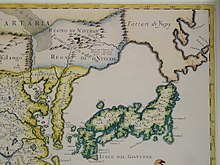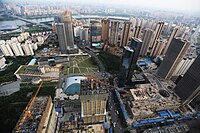Liaoning
Liaoning (![]() Liáo-Ning (?·i) in simplified Chinese, in traditional Chinese, ; pinyin, Liáoníng) is one of the twenty-two provinces of the People's Republic of China. Located on the south coast of the northeastern region of the country. Its most populated capital and city is Shenyang.
Liáo-Ning (?·i) in simplified Chinese, in traditional Chinese, ; pinyin, Liáoníng) is one of the twenty-two provinces of the People's Republic of China. Located on the south coast of the northeastern region of the country. Its most populated capital and city is Shenyang.
The modern province of Liaoning was established in 1907 as the province of Fengtian (奉天, Fèngtiān; old postal system: Fengtien) and passed renamed Liaoning in 1929, also known as Mukden Province at the time from the Manchu pronunciation of Shengjing, the former name of the province's capital, Shenyang. Under the Japanese puppet state of Manchukuo, the province reverted to its 1907 name, but the Liaoning name was restored in 1945 and again in 1954. "Liao" is the ancient name for the region, adopted by the Liao dynasty, which ruled the area between the year 907 and 1125. "Ning" means "peaceful."
Liaoning is also known in Chinese as "the Golden Triangle" because of its shape and strategic location. It is bordered by the Yellow Sea (Korea Bay and Bohai Sea) in the south, North Pyongan and Chagang provinces North Korea to the southeast, and the Chinese provinces of Jilin to the northeast and Hebei to the southwest, and the Chinese autonomous region of Inner Mongolia to the northwest. The Yalu River marks its border with North Korea, flowing into the Korea Bay between Dandong in Liaoning and Sinuiju in North Korea.
History
The Qin and Han dynasties already ruled a large part of the area that is now the province of Liaoning, although later the government of the region passed into the hands of other peoples such as the Xianbei, the Goguryeo, the Khitan or the Jurchen. During the 17th century, the Manchus established their capital at Shenyang before conquering the rest of China and establishing the Qing dynasty in 1644.. In the second half of the century, the imperial government recruited emigrants from Shandong to colonize the sparsely populated region. Many of today's Liaoning people are descended from those settlers. During the remainder of the Manchu period, Manchuria was ruled by three generals, one of whom, the Shengjing general, ruled over most of modern Liaoning.

In 1860, the Manchu government reopened the province to migration. The result was that the Han became the dominant ethnic group in the region. In the 20th century the province of Fengtian was established in what is now Liaoning. During the Russo-Japanese War of 1904-1905, many key battles took place in Liaoning. During the era of warlords, in the early XX century, the province came under the Fengtian cabal, including Zhang Zuolin and his son Zhang Xueliang. In 1931, Japan invaded the province, which remained under Japanese control during the Manchukuo state period. Japanese troops withdrew from Liaoning in 1945. The first major battles of the Chinese civil war (Liaoshen campaign) took place in and around Liaoning.
When the People's Republic of China was founded in 1949, Liaoning did not exist. In its place were two provinces, Liaodong and Liaoxi, and five municipalities, Shenyang, Lüda, Anshan, Fushun and Benxi. The present province was established in 1954, including parts of the former Rehe province. During the Cultural Revolution, Liaoning was temporarily part of the Inner Mongolia region.
Liaoning was one of the first Chinese provinces to be industrialized, first under Japanese occupation and then during the 1950s and 1960s. In the city of Anshan, for example, is one of the largest iron and steel manufacturing complexes in all of China. In the early 2000s, many of the state-controlled companies experienced financial difficulties. Recognizing the special difficulties faced by Liaoning and the other northeastern provinces, the Chinese government launched the Northeast Revival campaign.
Partial list of provincial governors:
- Chen Puru (1980-1983)
- Quan Shuren (1983-1986)
- Li Changchun (1986-1990)
- Yue Qifeng (1990-1994)
- Wen Shizhen (1994-1998)
- Zhang Guoguang (1998-2001)
- Bo Xilai (2001-2004)
- Zhang Wenyue (2004-2007)
- Chen Zhenggao (2007-2014)
- Li Xi (2014-2015)
- Chen Qiufa (2015-2017)
- Tang Yijun (2017-?)
Geography
Liaoning is divided into three geographical regions: the western highlands, the central plains, and the eastern mountains.
In the western highlands lie the Nulu'erhu Mountains, which roughly follow the border between Liaoning and Inner Mongolia. The entire region is dominated by low-lying hills.
In the central area are the basins of the Liao and Daliao rivers and their tributaries. The area is mainly flat and low altitude.
The eastern part is dominated by the Changbai and Qian mountain ranges, which stretch out to the sea to form the Liaodong Peninsula. The highest point of the province, Mount Huabozi (1,336 meters) is located in this area.
The climate is continental monsoonal and the average annual rainfall ranges between 440 and 1130 mm. Summer is rainy and the other seasons are dry.
Economy
Liaoning's main agricultural products are corn, sorghum and soybeans. In the surroundings of Dalian, three quarters of the Chinese production of apples and peaches dedicated to export are produced. Cotton is also produced.
It has the largest deposits of iron, magnesium, diamonds and boron in the entire People's Republic. It is also an important source of oil and natural gas. Salt is also produced on the coast.
It is one of the main industrial bases in China, covering a wide range: machinery, electronics, metal refining, petroleum, chemicals, construction materials, coal...
The city of Dalian has become an important port and the gateway for exports to the entire Northeast.
In 2004, nominal GDP was 687.3 billion yuan ($85.27 billion), ranking 8th in the People's Republic. The per capita income was 14,300 yuan ($1,727).
Demographics
| Figure of evolution of Liaoning between 1912 and 2010 |
 |
The province's population is predominantly Han, with Manchu, Mongol, Hui, Korean, and Xibe minorities.
| Ethnic composition of Liaoning, 2000 census* | ||
|---|---|---|
| Nationality | Population | Percentage |
| Han | 35 105 991 | 83.94% |
| Manchu | 5 385 287 | 12.88% |
| Mongol | 669 972 | 1.60% |
| Hui | 264 407 | 0.632% |
| Korean | 241 052 | 0.576% |
| Xibe | 132 615 | 0.317% |
| (*) Does not include PPL members in active service | ||
Paleontology
Liaoning is known for the discovery of extraordinary fossils from the Lower Cretaceous of the Yixian Formation. The first feathered dinosaur, Sinosauropteryx prima, was discovered here and released in 1996. Other notable discoveries have included an intact pterosaur embryo; the Repenomamus (a cat-sized mammal that ate dinosaurs) and the Sinornithosaurus millenii. In 2004, paleontologists unearthed the first fossil of Mei long.
Tourism
In Shenyang is the Imperial Palace, which was the residence of the Qing dynasty before they conquered the rest of China and moved the capital to Beijing. Although not as large or famous as the Forbidden City, it is important for its representation of the palace architecture of the time, and has recently been included in the list of UNESCO World Heritage Sites as an extension of the Imperial Palace in Beijing.
Three imperial tombs from the Qing dynasty have also been listed by UNESCO along with others from the Ming and Qing dynasties (Ming Tombs in Beijing and Ming Xiaoling Tomb in Nanjing). Huang Taiji, founder of the Qing dynasty, is buried in the North Tomb (北陵).
The 18th of September History Museum (九一八历史博物馆) is dedicated to the Japanese occupation of Manchuria. The botanical garden is also interesting.
The port city of Dalian, at the tip of the Liaodong Peninsula, with its architecture from the Russian and Japanese eras, is a tourist destination in its own right, with beaches, resorts, zoos and trams and where tourists can go shopping and tasting seafood, which makes it a unique place in China.
Dandong is a medium-sized city from which you can see the North Korean city of Sinŭiju across the Yalu River and visit the easternmost stretch of the Great Wall, called the Tiger Mountain Great Wall (虎山长城).
Wunu Mountain City, a Goguryeo site found in the Manchu Autonomous County of Huanren, is also part of a UNESCO combo that includes other sites in Ji'an, Jilin.
In Anshan is the Jade Buddha, the largest statue of its kind in the world.
Liaoyang has several historical sites, such as the White Pagoda from the Yuan Dynasty.
In Dandong, there is the War Memorial to Resist US Aggression and Help Korea. It is the only official museum in China commemorating the Chinese participation in the Korean War (officially known in China as the "War to Resist US Aggression and Aid Korea").
Administrative division
Liaoning is made up of 14 prefectural cities, which in turn administer 100 district divisions (17 district-level cities, 19 districts, 8 autonomous districts, and 56 sectors) that are divided into 1,511 municipal-level divisions (613 cities, 301 municipalities, 77 ethnic municipalities and 520 sub-sectors).
Contenido relacionado
South Africa
Cantabrian Sea
Beijing



